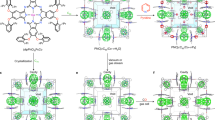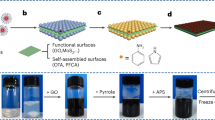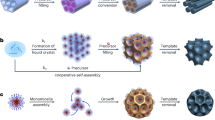Abstract
Open framework metal chalcogenide solids, with pore sizes in the nano- and mesoscale, are of potentially broad technological and fundamental interest in research areas ranging from optoelectronics to the physics of quantum confinement1,2. Although there have been significant advances in the design and synthesis of mesostructured silicas3,4, the construction of their non-oxidic analogues still remains a challenge. Here we describe a synthetic strategy that allows the preparation of a large class of mesoporous materials based on supramolecular assembly of tetrahedral Zintl anions [SnSe4]4- with transition metals in the presence of cetylpyridinium (CP) surfactant molecules. These mesostructured semiconducting selenide materials are of the general formulae (CP)4-2xMxSnSe4 (where 1.0 < x < 1.3; M=Mn, Fe, Co, Zn, Cd, Hg). The resulting materials are open framework chalcogenides and form mesophases with uniform pore size (with spacings between 35 and 40 Å). The pore arrangement depends on the synthetic conditions and metal used, and include disordered wormhole, hexagonal and even cubic phases. All compounds are medium bandgap semiconductors (varying between 1.4 and 2.5 eV). We expect that such semiconducting porous networks could be used for optoelectronic, photosynthetic and photocatalytic applications.
This is a preview of subscription content, access via your institution
Access options
Subscribe to this journal
Receive 51 print issues and online access
$199.00 per year
only $3.90 per issue
Buy this article
- Purchase on Springer Link
- Instant access to full article PDF
Prices may be subject to local taxes which are calculated during checkout




Similar content being viewed by others
References
Weiss, D. et al. Quantized periodic-orbits in large antidot arrays. Phys. Rev. Lett. 70, 4118–4121 (1993).
Ozin, G. A. Nanomaterials—endosemiconductors and exosemiconductors. Adv. Chem. Ser. 245, 335–371 (1995).
Kresge, C. T., Leonowicz, M. E., Roth, W. J., Vartuli, J. C. & Beck, J. S. Ordered mesoporous molecular-sieves synthesized by a liquid-crystal template mechanism. Nature 359, 710–712 (1992).
Beck, J. S. et al. A new family of mesoporous molecular sieves prepared with liquid-crystal templates. J. Am. Chem. Soc. 114, 10834–10843 (1992).
Ying, J. Y., Mehnert, C. P. & Wong, M. S. Synthesis and applications of supramolecular-templated mesoporous materials. Angew. Chem. Int. Edn Engl. 38, 56–77 (1999).
Ciesla, U., Schacht, S., Stucky, G. D., Unger, K. K. & Schuth, F. Formation of a porous zirconium oxo phosphate with a high surface area by a surfactant-assisted synthesis. Angew. Chem. Int. Edn Engl. 35, 541–543 (1996).
Attard, G. S., Goltner, C. G., Corker, J. M., Henke, S. & Templer, R. H. Liquid-crystal templates for nanostructured metals. Angew. Chem. Int. Edn Engl. 36, 1315–1317 (1997).
Braun, P. V., Osenar, P. & Stupp, S. I. Semiconducting superlattices templated by molecular assemblies. Nature 380, 325–328 (1996).
Li, H. L. et al. Supertetrahedral sulfide crystals with giant cavities and channels. Science 283, 1145–1147 (1999).
Bowes, C. L. & Ozin, G. A. Self-assembling frameworks: Beyond microporous oxides. Adv. Mater. 8, 13–18 (1996).
MacLachlan, M. J., Coombs, N. & Ozin, G. A. Non-aqueous supramolecular assembly of mesostructured metal germanium sulphides from (Ge4S10)4- clusters. Nature 397, 681–684 (1999).
Wachhold, M. et al. Mesostructured non-oxidic solids with adjustable worm-hole shaped pores: M-Ge-Q (Q = S, Se) frameworks based on tetrahedral [Ge4Q10]4- clusters. Adv. Mater. 12, 85–91 (2000).
Rangan, K. K., Billinge, S. J. L., Petkov, V., Heising, J. & Kanatzidis, M. G. Aqueous mediated synthesis of mesostructured manganese germanium sulfide with hexagonal order. Chem. Mater. 11, 2629–2632 (1999).
Wachhold, M. et al. Mesostructured metal germanium sulfide and selenide materials based on the tetrahedral [Ge4S10]4- and [Ge4Se10]4- units: Surfactant templated three-dimensional disordered frameworks perforated with worm holes. J. Solid State Chem. 152, 21–36 (2000).
Klepp, K. O. Na4SnSe4 and K4SnSe4, new selenostannates with discrete anions. Z. Naturforsch. B 47, 411–417 (1992).
Zhao, D. Y., Luan, Z. H. & Kevan, L. Synthesis of thermally stable mesoporous hexagonal aluminophosphate molecular sieves. Chem. Commun. 1009–1010 (1997).
Lippens, P. E. Interpretation of 119Sn Mössbauer isomer shifts in complex tin chalcogenides. Phys. Rev. B 60, 4576–4586 (1999).
Pankove, J. I. Optical Processes in Semiconductors (Dover, New York, 1971).
Acknowledgements
This work made use of the SEM and TEM facilities of the Center for Advanced Microscopy at Michigan State University. Financial support from the National Science Foundation is gratefully acknowledged.
Author information
Authors and Affiliations
Corresponding author
Rights and permissions
About this article
Cite this article
Trikalitis, P., Rangan, K., Bakas, T. et al. Varied pore organization in mesostructured semiconductors based on the [SnSe4]4- anion. Nature 410, 671–675 (2001). https://doi.org/10.1038/35070533
Received:
Accepted:
Issue Date:
DOI: https://doi.org/10.1038/35070533
This article is cited by
-
Instant synthesis of mesoporous monolithic materials with controllable geometry, dimension and stability: a review
Journal of Porous Materials (2011)
-
Mesolamellar phases containing [Fe(CN)6]3− anion
Journal of Materials Science (2010)
-
Mesoporous germanium-rich chalcogenido frameworks with highly polarizable surfaces and relevance to gas separation
Nature Materials (2009)
-
Exploration of nanostructured channel systems with single-molecule probes
Nature Materials (2007)
-
A guest-free germanium clathrate
Nature (2006)
Comments
By submitting a comment you agree to abide by our Terms and Community Guidelines. If you find something abusive or that does not comply with our terms or guidelines please flag it as inappropriate.



